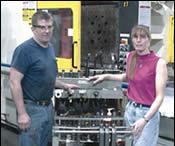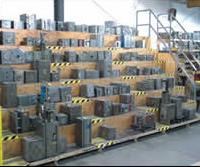Avoid Common Mold Set-Up Mistakes
Every molding machine has to shut down periodically for a mold set-up.
Every molding machine has to shut down periodically for a mold set-up. Unfortunately, machines are commonly out of action far longer than necessary due to avoidable mistakes in set-up procedures. A poorly planned or executed mold set-up can resemble a comedy of errors. When the machine is started up again, the result can be slow cycles, high scrap rates, tool damage, defective parts, rework, an unstable process, late delivery of product, and the loss of profit margin on the job.
Since it opened in 1984, Donnelly Custom Manufacturing has embraced the challenge of perfecting the mold changeover process rather than just accepting it as a necessary chore. Along the way, we have acquired some insight on avoiding common mistakes. Getting change-overs right is particularly important to our focus on short-run manufacturing. Our approach works: Mold- change times have been trimmed by 50% over the past two years, and we’re now able to complete many change overs for smaller presses in less than 30 min and for our largest presses within 2 hr.
Donnelly has 27 injection presses from 28 to 720 tons, executes an average of 30 (and as many as 55) mold changes a day, and usually performs from 190 to 210 set-ups weekly. Some production runs can be as short as 15 min, although a 10-hr run is the average. An extra 10 min on set-up can erase the profit on a run of less than 2 hr.
TIP No. 1
Avoid Unnecessary Idling
At many molders, once the press completes its last cycle, it typically is shut down and sits idle while the changeover crew takes out the finished mold and puts it away, locates and retrieves the next mold, stages any required auxiliary equipment, and finally conducts the set-up.
We recommend pre-staging the next mold changeover while the press is still in production with the current mold. Use a set-up cart that contains all of the tools necessary to tear down and set up the mold. The cart should include torque wrenches, impact wrenches, mold clamps and bolts, nozzles, cleaners, and any other equipment required. A member of the crew should go over the set-up cart during the pre-staging effort to ensure it isn’t missing any essential items. Pre-staging helped Donnelly shave as much as 33% off the average changeover time.
Scheduling and staging material in time is also critical. Many materials require pre-drying from 2 to 6 hr before processing. Failure to adequately schedule and pre-stage the material has the potential to idle a press much longer than the rest of the changeover activities combined.
Prioritize the set-up crew’s activities: Concentrate on getting the new mold up and running first, not on putting the just-removed mold into storage. There’s time for that after the changeover is complete and production resumes.
TIP No. 2
Organize Mold Storage
A trouble spot for many molders is mold storage. They often waste time finding and retrieving molds. Part of the problem is inefficient ways of storing and inventorying molds. Another part of the problem is storing molds too far away from the press. To improve mold storage and retrieval, Donnelly built what we call mold grandstands. They resemble high-school bleachers (see photo) and are located adjacent to the press. Every mold is assigned a place on a specific rack, and each mold is numbered. The most frequently run molds are stored where they are easiest to reach. So, when a mold is needed, one of the crew performing the changeover needs only to walk across the aisle to retrieve the mold. An overhead crane is used to transport the molds. We have separate grandstands for small and medium-size molds, while the larger molds are stored on a vertical racking system near the large injection machines.
TIP No. 3
Follow a Checklist
In the absence of a defined process for changeovers, molders may face long start-ups and other challenges that adversely affect market competitiveness. Establishing a checklist for the tools and steps for mold connection to the press is vital. Production supervisors at Donnelly use the checklist to make sure each scheduled changeover was completed and to evaluate how well it was done. Donnelly analyzes every changeover and looks for ways to improve the process. Even non-machine-related factors, such as material drying, can be reviewed closely for areas of improvement.
In fact, we go so far as to create an instruction manual for each of the molds we run. It includes checking the first and last parts in a job run for signs of warpage, flashing, mold wear, and other process maladies. We also have a checklist for the auxiliary equipment used, which is a part of the work order.
TIP No. 4 Commit to Training
Sometimes mold set-ups are protracted simply because there are too few people in the shop qualified to execute a mold changeover. In even a small molding shop, it is not uncommon to have several machines due for mold set-ups at the same time. Yet many molders rely on just one or two specialists. That means presses may remain idle while specialists are bogged down during busy periods or difficult set-ups.
This can be avoided by training press operators to do mold changeovers. Donnelly has trained 40% of its hourly personnel for this task. Not only can all changeovers be done in a timely fashion, but set-up times have also been reduced since press operators are able to pitch in and help in all phases of the process. Shift supervisors now create ad hoc changeover teams of certified molding operators on a daily basis, rather than having only one person or one crew perform them.
Donnelly also has a proven formula for executing changeovers: Always use two-person teams, regardless of press size. The team members have defined roles and work one on each side of the press. Over half the 60 people trained to perform mold changeovers at Donnelly are women.
TIP No. 5
Communicate Effectively
Production schedules change unexpectedly. This leaves many molding firms scrambling to address issues of who, what, where, when, and how right before a press is due to be changed. Often the result is that the press sits idle longer than necessary.
One way to avoid this situation is to conduct daily production meetings. Donnelly uses a “Manufacturing War Room” concept developed by International Plastics Consulting Corp. in Stamford, Conn. Daily meetings are held between cross-functional teams to review and discuss the job schedule and make assessments of priorities and resources. The daily meetings help to anticipate and minimize unplanned glitches throughout the manufacturing sequence, including mold change-overs. Any problem that can affect part production, quality, and delivery is placed on a board in the Manufacturing War Room and is resolved within 48 hr.
It pays to get as much feedback as possible from everyone associated with the mold-change process. Doing so helps ensure the process is continually honed. And you never know where the next good idea will originate.
TIP No. 6
Don’t Neglect Maintenance
A common mistake among molders is to compromise on equipment maintenance. A broken ejector pin, stripped-out bolt hole on a platen, or a worn check ring will delay the successful start up of a mold.
Based in Alexandria, Minn., Donnelly is a custom injection molder with more than 200 employees, Dave Lamb is director of manufacturing; Brad Andrist is training and continuous-improvement coordinator.
Related Content
How to Optimize Pack & Hold Times for Hot-Runner & Valve-Gated Molds
Applying a scientific method to what is typically a trial-and-error process. Part 2 of 2.
Read MoreHow to Mount an Injection Mold
Five industry pros with more than 200 years of combined molding experience provide step-by-step best practices on mounting a mold in a horizontal injection molding machine.
Read MoreHow to Set Barrel Zone Temps in Injection Molding
Start by picking a target melt temperature, and double-check data sheets for the resin supplier’s recommendations. Now for the rest...
Read MoreRead Next
Troubleshooting Screw and Barrel Wear in Extrusion
Extruder screws and barrels will wear over time. If you are seeing a reduction in specific rate and higher discharge temperatures, wear is the likely culprit.
Read MoreAdvanced Recycling: Beyond Pyrolysis
Consumer-product brand owners increasingly see advanced chemical recycling as a necessary complement to mechanical recycling if they are to meet ambitious goals for a circular economy in the next decade. Dozens of technology providers are developing new technologies to overcome the limitations of existing pyrolysis methods and to commercialize various alternative approaches to chemical recycling of plastics.
Read MorePeople 4.0 – How to Get Buy-In from Your Staff for Industry 4.0 Systems
Implementing a production monitoring system as the foundation of a ‘smart factory’ is about integrating people with new technology as much as it is about integrating machines and computers. Here are tips from a company that has gone through the process.
Read More























.png;maxWidth=300;quality=90)







